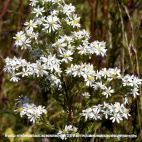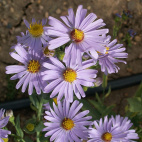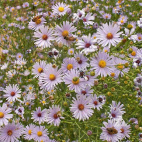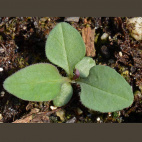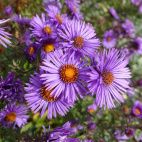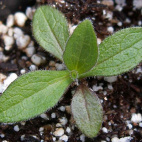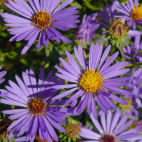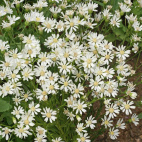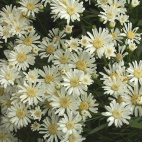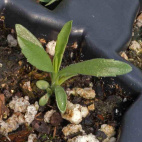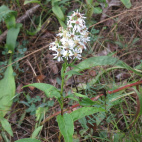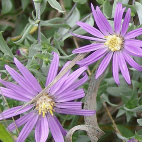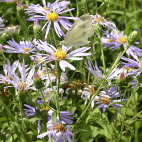Sky Blue Aster Seeds
- HOW TO GROW
- FAST FACTS
- REVIEWS
HOW TO GROW
Sowing: In late fall, direct sow the seed 1/4" deep in dry to medium soil and full sun. This Sky Blue Aster plant also adapts well to moist, sandy, or clay soil. For spring planting, stratify the seed by mixing it with moist sand and storing it in a plastic bag in the refrigerator for 4-6 weeks before direct sowing. To start the plants indoors, stratify the seeds, then sow two or three seeds each in small peat pots 1/4" deep. Keep the soil lightly moist and at a temperature of 70-75 degrees F until germination, which should take place within 10-14 days. Thin to the strongest seedling, and transplant 15-18" apart after the last spring frost.
Growing: Because this Sky Blue Aster plant adapts well to either drought or moisture, watering is optional. It grows rather slowly, and may not produce flowers until its second year of growth. Mature plants may be divided. This plant will self seed unless the wilted flowers are removed. Bees and butterflies are attracted to these flowers.
Harvesting: For fresh flowers, cut the stems of blossoms that are about half open; change the water often for a vase life of 7-10 days. For dried flowers, bundle the stems and hang them upside down in a dark, warm place until dry.
Seed Saving: After the first hard frost or when the flowers stop blooming, the seed heads will begin to form. Since small birds love to eat the seed, harvest the fluffy seed material promptly to avoid loss. Cut the entire top of the plant, or shake it into a container to collect the seed. Clean Sky Blue Aster flower seeds as well as possible, and store it in a cool, dry place.
FAST FACTS
Common Names: Azure Aster
Latin Name: Aster azureus
Species Origin: US Native Wildflower
Type: Native Wildflowers
Life Cycle: Perennial
USDA Zones: 3, 4, 5, 6, 7, 8, 9
US Regions: Midwest, Northern, Northeast, Southeast
Seeds per Ounce: 80,000
Stratification: No Stratification
Germination Ease: No Stratification
Sunlight: Full Sun, Part Sun
Height: 36 Inches
Color: Blue
Bloom Season: Blooms Early Fall, Blooms Late Fall
Uses: Attracts Pollinators, Attracts Honeybees, Attracts Butterflies, Cut Flowers
The answer to prayer
I love to help spread the plants that already grow here, and Everwilde gives me a chance now that I am too old and crippled to collect seeds myself! The beautiful and functional packages are a plus: I am saving them and displaying them....thanks so much.
Nothing sprouted
I followed the directions for direct seeding outside, and I tried them inside with the paper towel method. Nothing happened.
Hello, nothing will happen if these seeds were planted outside before they go through the winter cycle. If you are planting in the spring, they need to go through the stratification process first. We will be happy to send you another packet for you to try again.
DESCRIPTION

HOW TO GROW
Sowing: In late fall, direct sow the seed 1/4" deep in dry to medium soil and full sun. This Sky Blue Aster plant also adapts well to moist, sandy, or clay soil. For spring planting, stratify the seed by mixing it with moist sand and storing it in a plastic bag in the refrigerator for 4-6 weeks before direct sowing. To start the plants indoors, stratify the seeds, then sow two or three seeds each in small peat pots 1/4" deep. Keep the soil lightly moist and at a temperature of 70-75 degrees F until germination, which should take place within 10-14 days. Thin to the strongest seedling, and transplant 15-18" apart after the last spring frost.
Growing: Because this Sky Blue Aster plant adapts well to either drought or moisture, watering is optional. It grows rather slowly, and may not produce flowers until its second year of growth. Mature plants may be divided. This plant will self seed unless the wilted flowers are removed. Bees and butterflies are attracted to these flowers.
Harvesting: For fresh flowers, cut the stems of blossoms that are about half open; change the water often for a vase life of 7-10 days. For dried flowers, bundle the stems and hang them upside down in a dark, warm place until dry.
Seed Saving: After the first hard frost or when the flowers stop blooming, the seed heads will begin to form. Since small birds love to eat the seed, harvest the fluffy seed material promptly to avoid loss. Cut the entire top of the plant, or shake it into a container to collect the seed. Clean Sky Blue Aster flower seeds as well as possible, and store it in a cool, dry place.
FAST FACTS
Common Names: Azure Aster
Latin Name: Aster azureus
Species Origin: US Native Wildflower
Type: Native Wildflowers
Life Cycle: Perennial
USDA Zones: 3, 4, 5, 6, 7, 8, 9
US Regions: Midwest, Northern, Northeast, Southeast
Seeds per Ounce: 80,000
Stratification: No Stratification
Germination Ease: No Stratification
Sunlight: Full Sun, Part Sun
Height: 36 Inches
Color: Blue
Bloom Season: Blooms Early Fall, Blooms Late Fall
Uses: Attracts Pollinators, Attracts Honeybees, Attracts Butterflies, Cut Flowers
Reviews
Review
The answer to prayer
I love to help spread the plants that already grow here, and Everwilde gives me a chance now that I am too old and crippled to collect seeds myself! The beautiful and functional packages are a plus: I am saving them and displaying them....thanks so much.
Review
Nothing sprouted
I followed the directions for direct seeding outside, and I tried them inside with the paper towel method. Nothing happened.
Hello, nothing will happen if these seeds were planted outside before they go through the winter cycle. If you are planting in the spring, they need to go through the stratification process first. We will be happy to send you another packet for you to try again.
Also Consider These:
-
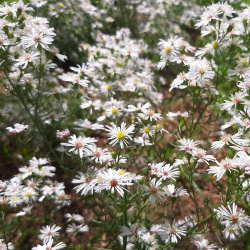 Heath Aster Seeds
Aster ericoides
Named for their resemblance to the white heath of the moors of England, these Asters thrive in dry, rocky prairies or pastures. Since it spreads easily, it will eventually form extended colonies of attractive white bushes.Quick View$3.75 Pkt - $100.00 / Oz
Heath Aster Seeds
Aster ericoides
Named for their resemblance to the white heath of the moors of England, these Asters thrive in dry, rocky prairies or pastures. Since it spreads easily, it will eventually form extended colonies of attractive white bushes.Quick View$3.75 Pkt - $100.00 / Oz -
 On Sale!
Smooth Blue Aster Seeds
Aster laevis
These bright blue flowers will add color to the autumn landscape. Unlike many asters, this variety produces perfectly smooth foliage and stems. This Aster is widely used in prairie restoration mixes.Quick View$3.75 Pkt - $15.95 / Oz
On Sale!
Smooth Blue Aster Seeds
Aster laevis
These bright blue flowers will add color to the autumn landscape. Unlike many asters, this variety produces perfectly smooth foliage and stems. This Aster is widely used in prairie restoration mixes.Quick View$3.75 Pkt - $15.95 / Oz -
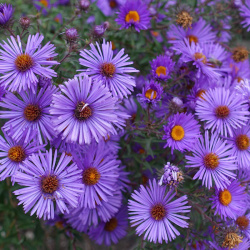 On Sale!
New England Aster Seeds
Aster novae-angliae
One of the most lovely and popular of the large asters, these fuschia flowers provide color for all of the autumn season. This variety is popular for prairie restoration projects because it provides a late-season source for pollen and nectar for our pollinator friends.Quick Viewx
On Sale!
New England Aster Seeds
Aster novae-angliae
One of the most lovely and popular of the large asters, these fuschia flowers provide color for all of the autumn season. This variety is popular for prairie restoration projects because it provides a late-season source for pollen and nectar for our pollinator friends.Quick ViewxNew England Aster Seeds
Aster novae-angliae
One of the most lovely and popular of the large asters, these fuschia flowers provide color for all of the autumn season. This variety is popular for prairie restoration projects because it provides a late-season source for pollen and nectar for our pollinator friends.
$3.48 Pkt - $22.17 / Oz -
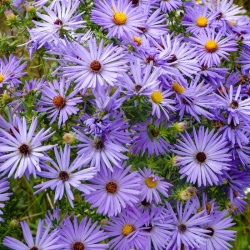 On Sale!
Aromatic Aster Seeds
Aster oblongifolius
Distinguished by its attractive balsam-scented foliage, this large Aster blooms very late in the fall. Though rather uncommon in the wild, this lavender variety usually grows in rough, dry ground or prairie soil.Quick View$3.75 Pkt - $48.00 / Oz
On Sale!
Aromatic Aster Seeds
Aster oblongifolius
Distinguished by its attractive balsam-scented foliage, this large Aster blooms very late in the fall. Though rather uncommon in the wild, this lavender variety usually grows in rough, dry ground or prairie soil.Quick View$3.75 Pkt - $48.00 / Oz -
 On Sale!
White Upland Aster Seeds
Aster ptarmicoides
Though not a true Aster, this plant is characterized by its profusion of white flowers. This variety does well in even the poorest, driest soil, and will provide some late-season color and nectar for winged garden visitors.Quick View$3.48 Pkt - $18.77 / Oz
On Sale!
White Upland Aster Seeds
Aster ptarmicoides
Though not a true Aster, this plant is characterized by its profusion of white flowers. This variety does well in even the poorest, driest soil, and will provide some late-season color and nectar for winged garden visitors.Quick View$3.48 Pkt - $18.77 / Oz -
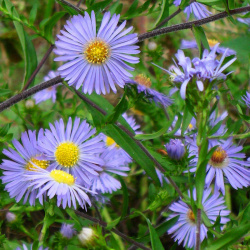 Swamp Aster Seeds
Aster puniceus
Found from northern Canada to southern Texas, this wildflower has one of the largest growing areas of any aster. The perennial usually grows in wetland or marshes, but will grow in average garden soil as well.Quick View$3.75 Pkt - $50.00 / Oz
Swamp Aster Seeds
Aster puniceus
Found from northern Canada to southern Texas, this wildflower has one of the largest growing areas of any aster. The perennial usually grows in wetland or marshes, but will grow in average garden soil as well.Quick View$3.75 Pkt - $50.00 / Oz -
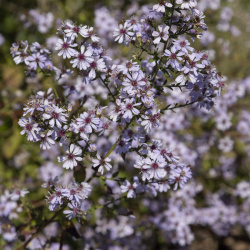 Arrow Leaved Aster Seeds
Aster sagittifolius
Delightful clusters of pale blue and lavender flowers add beauty to any planting in the fall season. Though no longer common in the wild, this Aster occasionally grows in open woodland areas or prairies.Quick View$3.75 Pkt - $54.00 / Oz
Arrow Leaved Aster Seeds
Aster sagittifolius
Delightful clusters of pale blue and lavender flowers add beauty to any planting in the fall season. Though no longer common in the wild, this Aster occasionally grows in open woodland areas or prairies.Quick View$3.75 Pkt - $54.00 / Oz -
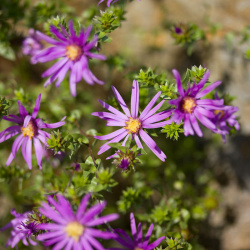 On Sale!
Silky Aster Seeds
Aster sericeus
Large flowers and attractive silvery foliage make this aster a popular choice for rock gardens and prairie plantings. The hardy, low-growing variety also distinguishes itself with unusual leaves, which feature fine white hairs.Quick View$3.96 Pkt - $64.00 / Oz
On Sale!
Silky Aster Seeds
Aster sericeus
Large flowers and attractive silvery foliage make this aster a popular choice for rock gardens and prairie plantings. The hardy, low-growing variety also distinguishes itself with unusual leaves, which feature fine white hairs.Quick View$3.96 Pkt - $64.00 / Oz -
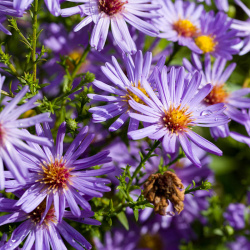 Out Of Stock
Showy Aster Seeds
Aster spectabilis
This New England native has become endangered in some states, though it can be found occasionally in coastal, sandy areas or open woods. Adaptability to almost any soil makes Aster Spectabilis an excellent choice for gardens or prairie plantings.Quick View$3.48 Pkt - $32.00 / Oz
Out Of Stock
Showy Aster Seeds
Aster spectabilis
This New England native has become endangered in some states, though it can be found occasionally in coastal, sandy areas or open woods. Adaptability to almost any soil makes Aster Spectabilis an excellent choice for gardens or prairie plantings.Quick View$3.48 Pkt - $32.00 / Oz







